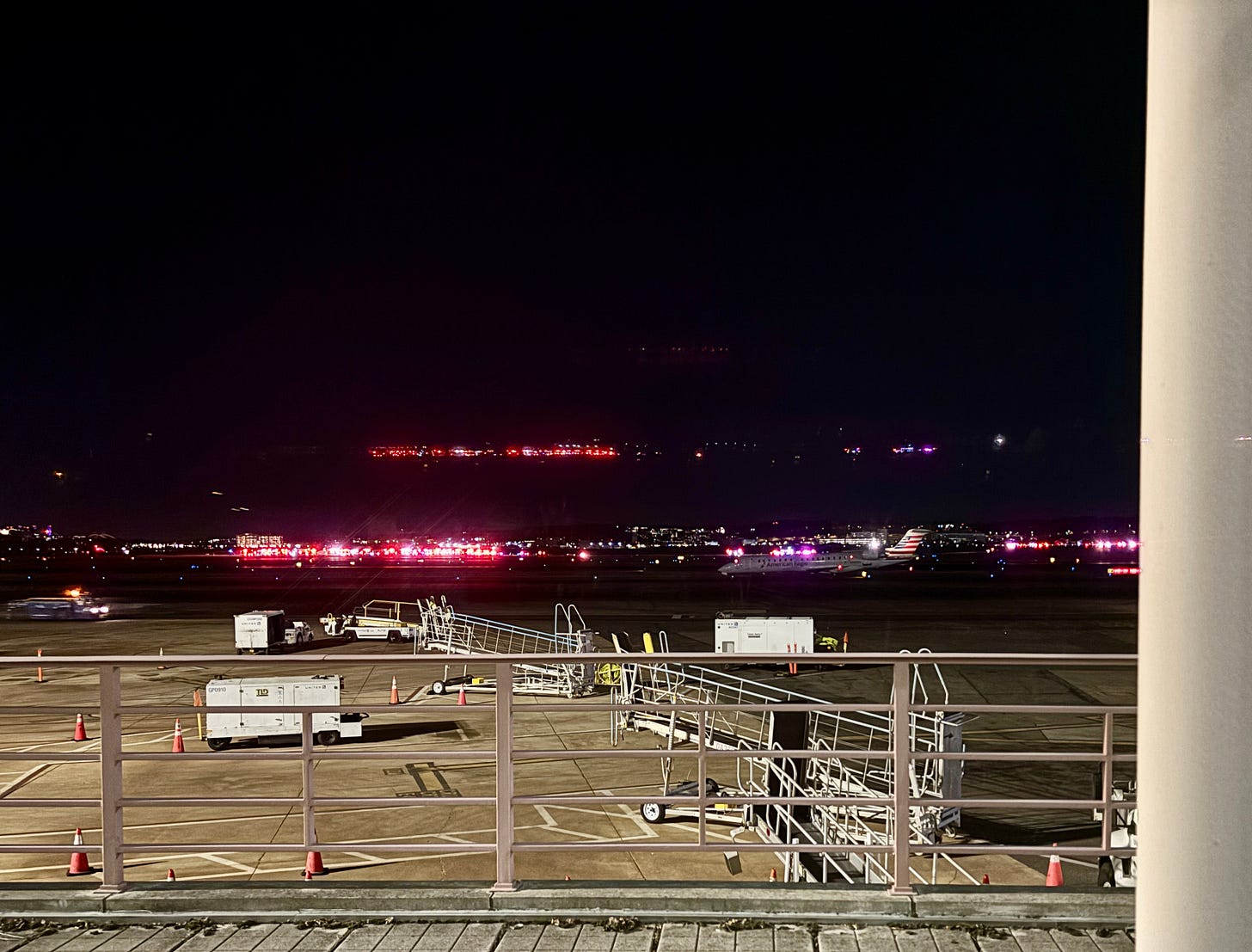A little before 8:50 p.m. local time Wednesday night in the skies over Washington, D.C., the 16 years and counting1 without a fatal airplane crash at a U.S. airline came to a tragic end.
American Airlines flight AA5342, a Mitsubishi (neé Bombardier) CRJ700 operated by PSA Airlines on final approach to Washington Reagan National Airport’s Runway 33, collided with a U.S. Army Black Hawk helicopter over the Potomac River. All 60 passengers and four crew members aboard the flight, and three crew aboard the helicopter are presumed dead.
I’m not going to offer any in-depth analysis of the situation here. I, like many Washingtonians, stood on the banks of the Potomac Wednesday night in shock over what happened. My aim is something of a compendium of the facts and analysis that are out there.
“Right now, [we’re] focusing on taking care of all passengers and crew involved, as well as their families,” American CEO Robert Isom said in a video message released about two hours after the accident.
As The Air Show podcast co-host and Cranky Flier author Brett Snyder put it Wednesday night, the message was “informative, timely, and strikes the right tone.”
The rescue effort shifted to recovery by the morning of Thursday, Jan. 30. The tragic fact was that, anyone who survived the initial collision, only had about 20-30 minutes in the Potomac — water temperatures were 35-36 degrees Fahrenheit and there was visible ice on the river — before hypothermia would set in.
Unfortunately, the government did not wait for the National Transportation Safety Board to offer its initial findings before starting to discuss possible causes, as would usually be the case. President Trump, weeks into his second term and flanked by several of his newly confirmed appointees, including Transportation Secretary Sean Duffy, broke with decades of precedent to offer his own thoughts on Thursday.
Jon Ostrower, Will Guisbond, and Elan Head at The Air Current did an excellent job putting the president’s words in context:
“The President of the United States shattered decades’ worth of precedent, both legal and cultural, that has guided heads of state to avoid any overt interference or appearance of the same in active air safety investigations. That precedent has contributed to the overall safety of the aviation system both in the U.S. and globally, allowing for probable cause — and ultimately measures to prevent future accidents — to be established unfettered from political agendas and considerations.”
Speculation, to be clear, has no place in an aviation accident investigation.
"With all due respect, I think the press also likes to state what probable cause is before we get to the probable cause,” NTSB Chair Jennifer Homendy said in response to a question on the president’s comments at the agency’s own briefing later on Thursday.
“We're going to conduct a thorough investigation of this entire tragedy, looking at the facts,” she said.
That is, and must be, what we expect from our accident investigation agencies.
“The NTSB will be the sole source of truth going forward, and accuracy is of the utmost importance,” Isom said in a memo to staff on Thursday shared with the media.
The truth is, errors when flying, like in every human endeavor, happen. That is why we have a “Swiss cheese” model for aviation safety.
in described this well:“The Swiss cheese model is a method of reducing risk by adding layers of safety which, by themselves, wouldn’t be enough, but together, create a comprehensive net. Picture a few slices of swiss cheese. Each of them have holes in random places. But when you stack enough of those slices up, each slice overlaps and covers the holes on the slice below, and all of the holes end up being covered up.”
Those holes tragically lined up on Wednesday night.
From here, we all must follow the NTSB’s lead on the investigation into AA5342. The agency will likely hold several more media briefings before they publish a preliminary report in 30 days. Then, it could be years before a final report is issued and then even longer before its recommendations are codified.
And we can all offer the families, friends, and loved ones of this tragic accident our thoughts and prayers.
Further Reading
See granular flight tracking data for both AA5342 and the helicopter on FlightRadar24
The control tower at National Airport was understaffed before deadly collision, according to reports citing a FAA air traffic safety report
The U.S. is suffering from a shortage of air traffic controllers, one that pre-dates Covid but was exacerbated by the hiring freeze and retirements during the pandemic
Passengers on AA5342 included young figure skaters, their families, and coaches returning from a training camp following the 2025 U.S. Figure Skating Championships in Wichita, some were even considered as “on track to make it to the highest levels of the sport, and maybe even the national team and the Olympics.”
Helicopters flying along the Potomac frequently pose dangers to passenger jets, at least two flights arriving at National in the days before the accident aborted landings due to potential conflicts with helicopters
The FAA lacked an administrator at the time of the accident, though Trump named Chris Rocheleau as acting administrator the day after
The NTSB recovered the black boxes — the flight data recorder and cockpit voice recorder — from AA5342 on Thursday night
Canada is providing assistance to the NTSB’s investigation, a common practice for the country where the aircraft involved (the CRJ700) was manufactured
Follow me on Bluesky for continuing updates on AA5342.
The latest fatal crash at a U.S. airline was Colgan Air flight 3407 operating as Continental Connection that killed all 49 onboard near Buffalo, N.Y., on February 12, 2009. There have been several accidents with fatalities since, including Asiana flight 214 in San Francisco in 2013 and Southwest flight 1380 en route from New York to Dallas in 2018.




